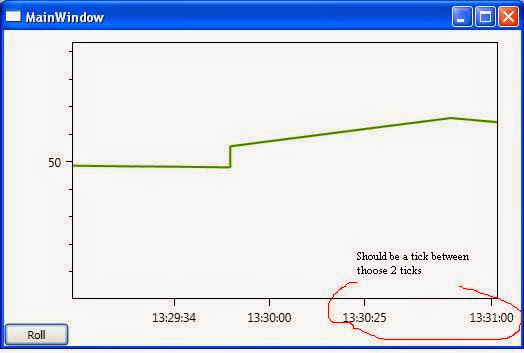
DateTimeAxis with IntervalType == DateTimeIntervalType.Minutes
This discussion was imported from CodePlex
swiszcz wrote at 2013-05-06 10:33:
Hi,
I want to display measurement data, where measurements were made every full minute (60 seconds), so I'm using DateTimeAxis with IntervalType == DateTimeIntervalType.Minutes on X axis. I'm using DateTimeAxis.ToDouble() to calculate x-coordinate and I obtain correct point series.
However, I was expecting ticks on the X axis to appear every full minute, but the actual distance between ticks is one minute +- a few seconds (see Example screen capture.).
Is there a way to have tick's distance equal to exactly 1 minute?
Regards,
Maciek
I want to display measurement data, where measurements were made every full minute (60 seconds), so I'm using DateTimeAxis with IntervalType == DateTimeIntervalType.Minutes on X axis. I'm using DateTimeAxis.ToDouble() to calculate x-coordinate and I obtain correct point series.
However, I was expecting ticks on the X axis to appear every full minute, but the actual distance between ticks is one minute +- a few seconds (see Example screen capture.).
Is there a way to have tick's distance equal to exactly 1 minute?
Regards,
Maciek
public static PlotModel DateTimeAxisExample()
{
var plotModel1 = new PlotModel();
var linearAxis1 = new LinearAxis();
linearAxis1.MinorGridlineStyle = LineStyle.Dot;
plotModel1.Axes.Add(linearAxis1);
var dateTimeAxis1 = new DateTimeAxis();
dateTimeAxis1.IntervalType = DateTimeIntervalType.Minutes;
dateTimeAxis1.EndPosition = 0;
dateTimeAxis1.StartPosition = 1;
dateTimeAxis1.StringFormat = "hh:mm:ss";
plotModel1.Axes.Add(dateTimeAxis1);
return plotModel1;
}objo wrote at 2013-05-06 11:10:
I think there is a bug in the
https://oxyplot.codeplex.com/workitem/10045
DateTimeAxis. Maybe this is related to double precision accuracy. I am adding a new issue:
https://oxyplot.codeplex.com/workitem/10045
swiszcz wrote at 2013-05-07 14:58:
Hi,
I've found that, in this case, in class: OxyPlot.Axes.Axis, in method: protected static IList<double> CreateTickValues(double min, double max, double step). commenting line: x = x.RemoveNoise(); solves a problem.
Good code, and a good library, by the way.
Thanks!
I've found that, in this case, in class: OxyPlot.Axes.Axis, in method: protected static IList<double> CreateTickValues(double min, double max, double step). commenting line: x = x.RemoveNoise(); solves a problem.
Good code, and a good library, by the way.
Thanks!
objo wrote at 2013-06-08 11:57:
Thanks for the solution, I will keep this in mind when looking into the DateTimeAxis again! I think I need to add more tests before I remove the 'RemoveNoise' line.
raphay wrote at 2013-07-04 15:31:
Hi,
I have another similar problem, sometimes at the minute or seconde scale, some major ticks doesn't appears

I use Nugget, so i wonder if the solution proposed by swiszcz is available in the lastest version.
Thank you for your answer, your work is awesome,
Regards
I have another similar problem, sometimes at the minute or seconde scale, some major ticks doesn't appears
I use Nugget, so i wonder if the solution proposed by swiszcz is available in the lastest version.
Thank you for your answer, your work is awesome,
Regards
swiszcz wrote at 2013-07-04 15:45:
Hi Raphay,
Although commenting line: x = x.RemoveNoise(); solves a my problem, i have no idea how does it influence the rest of a code (and it may as it is in a base class). So I just made a private fork of OxyPlot.
Best regards
Although commenting line: x = x.RemoveNoise(); solves a my problem, i have no idea how does it influence the rest of a code (and it may as it is in a base class). So I just made a private fork of OxyPlot.
Best regards
Customer support service by UserEcho

